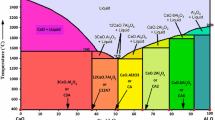Abstract
Thin-film samples of fluorides CaF2, BaF2, and LaF3, free of oxyfluorides, have been fabricated by ultrasonic fragmentation (CaF2) and sublimation in vacuum onto amorphous carbon substrates (BaF2 and LaF3). The electron diffraction patterns of these polycrystals are measured with a low statistical error (~1–2%) using an EMR-102 electron diffractometer. The reflection intensities were applied to refine the electronic structure; the refinement showed mainly ionic character of chemical bonding in these compounds. Electron density and electrostatic potential distributions were obtained using the parameters of kappa-model, which describes ionic bonding, and their quantitative analysis was performed within Bader’s topological approach. It is noted that the positions of “critical points” in the electrostatic potential and electron density maps for CaF2, BaF2, and LaF3 crystals do not exactly coincide. This finding has confirmed the well-known fact: the electron density (and energy) of a many-electron system is not completely determined by the innercrystalline electrostatic field. The electron density and electrostatic potential maps supplement each other when describing interatomic interactions. A consideration of the gradient field E(r) = –∇φ(r) in these crystals confirms the conclusion that long-range Coulomb interactions of atoms (having finite sizes) occur in the form of atom‒ atom interactions. The interaction forces and their directions in crystal is a peculiar property of each compound (specifically, each structure type).




Similar content being viewed by others
REFERENCES
N. I. Sorokin, A. M. Golubev, and B. P. Sobolev, Crystallogr. Rep. 59, 238 (2014).
A. S. Avilov and V. G. Tsirel’son, Crystallogr. Rep. 46 (4), 556 (2001).
V. G. Tsirelson, A. S. Avilov, G. G. Lepeshov, et al., J. Phys. Chem. B 105, 5068 (2001).
B. P. Sobolev, The Rare Earth Trifluorides, Part 1: The High Temperature Chemistry of the Rare Earth Trifluorides (Institute of Crystallography, Moscow, 2000; Institut d’Estudis Catalans, Barcelona, 2000).
A. Zalkin, D. H. Templeton, and T. E. Hopkins, Acta Crystallogr. B 41, 91 (1985).
A. P. Dudka, Crystallogr. Rep. 47, 152 (2002).
N. K. Hansen and P. Coppens, Acta Crystallogr. A 34, 909 (1978).
V. G. Tsirelson, A. S. Avilov, G. G. Lepeshov, et al., J. Phys. Chem. B 105, 5068 (2001).
B. K. Vainshtein, B. Zvyagin, and A. S. Avilov, Electron Diffraction Techniques (Oxford Univ. Press, Oxford, 1992), Vol. 1, Ch. 6, p. 216.
B. Maksimov and H. Schulz, Acta Crystallogr. B 41, 88 (1985).
Z. Su and P. Coppens, Acta Crystallogr. A 48, 188 (1992).
V. G. Tsirelson and R. P. Ozerov, Electron Density and Bonding in Crystals: Theory and Diffraction Experiments in Solid State Physics and Chemistry (Inst. of Physics, Bristol, 1996).
R. F. W. Bader, Atoms in Molecules: A Quantum Theory (Oxford Univ. Press, Oxford, 1990).
Y. Tal, R. F. W. Bader, and R. Erkku, Phys. Rev. A 21, 1 (1980).
R. P. Feynman, Phys. Rev. 56, 340 (1939).
I. E. Tamm, The Principles of Electricity Theory (Mir, Moscow, 1979).
ACKNOWLEDGMENTS
We are grateful to B.P. Sobolev for his interest in the study and fruitful discussions.
The study was supported by the Ministry of Science and Higher Education of the Russian Federation within a State contract with the Federal Scientific Research Centre “Crystallography and Photonics” of the Russian Academy of Sciences.
Author information
Authors and Affiliations
Corresponding author
Additional information
Translated by Yu. Sin’kov
Rights and permissions
About this article
Cite this article
Novikova, V.V., Kulygin, A.K., Lepeshov, G.G. et al. Electronic Structure and Electrostatic Potential Distribution in Nanocrystals of Fluorides CaF2, BaF2, and LaF3 According to Electron Diffraction Data. Crystallogr. Rep. 63, 883–890 (2018). https://doi.org/10.1134/S106377451806024X
Received:
Published:
Issue Date:
DOI: https://doi.org/10.1134/S106377451806024X



